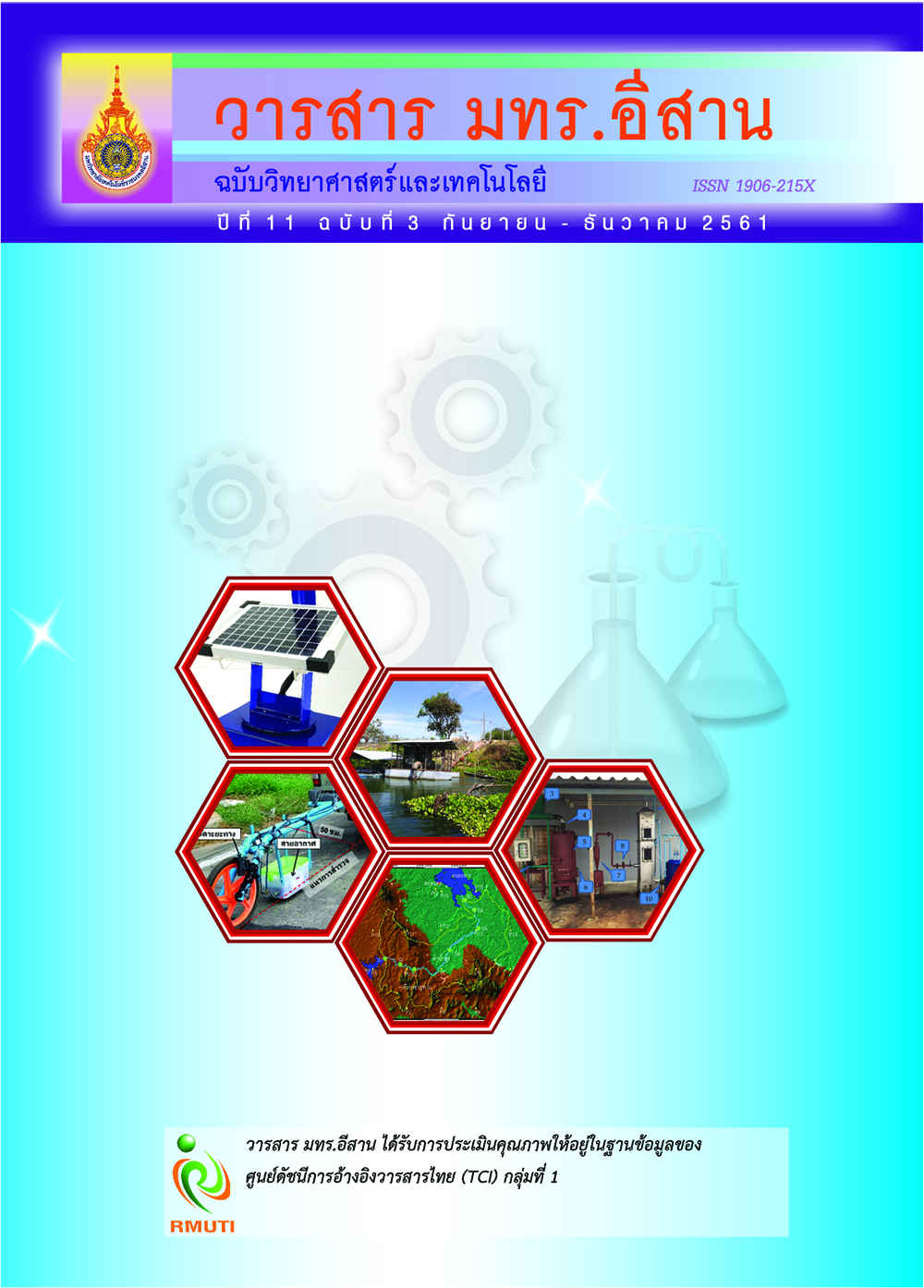Estimation of Total Suspended Solids in Pung River using Global Precipitation Measurement Data
Main Article Content
Abstract
The object of this research was investigated the possibility of using Global Precipitation Measurement Data (GPM) for estimating total suspended solids (TSS) in Pung River. The longitudinal change of TSS and the correlations between GPM data and TSS were examined. Moreover, the estimating models of TSS, which use GPM data as input data were developed, by using a Group Method of Data Handling (GMDH). The results indicated that the TSS levels in Pung River hange along the length of the channel, the upstream location had TSS value lower than the end of the river. Intermediate level of relationship between 3-days, 7-days, and 14-days of GPM precipitation and TSS values were disclosed. The TSS models using GPM data as input data had moderate effi ciency; the estimated values and the actual values varied in the same way. The validated models had the coefficient of determination of 0.41 - 0.89.
Article Details
References
[2] Bussi, G., Dadson, S. J., Prudhomme, C., and Whitehead, P. G. (2016). Modelling the Future Impacts of Climate and Land-Use Change on Suspended Sediment Transport in the River Thames (UK). Journal of Hydrology. Vol. 542, pp. 357-372. DOI: 10.1016/j.jhydrol.2016.09.010
[3] van Maren, D. S., Oost, A. P., Wang, Z. B., and Vos, P. C. (2016). The Effect of Land Reclamations and Sediment Extraction on the Suspended Sediment Concentration in the Ems Estuary. Marine Geology. Vol. 376, pp. 147-157. DOI: 10.1016/j.margeo.2016.03.007
[4] Tiecher, T., Minella, J. P. G., Caner, L., Evrard, O., Zafar, M., Capoane, V., Le Gall, M., and Santos, D. (2017). Quantifying Land use Contributions to Suspended Sediment in a Large Cultivated Catchment of Southern Brazil (Guaporé River, Rio Grande do Sul). Agriculture, Ecosystems and Environment. Vol. 237, pp. 95-108. DOI: 10.1016/j.agee.2016.12.004
[5] Abbott, S., Julian, J. P., Kamarinas, I., Meitzen, K. M., Fuller, I. C., McColl, S. T., and Dymond, J. R. (2017). State-Shifting at the Edge of Resilience: River Suspended Sediment Responses to Land use Change and Extreme Storms. Geomorphology. Vol. 305, pp. 49-60. DOI: 10.1016/j.geomorph.2017.09.004
[6] Grimaldi, S., Petroselli, A., Baldini, L., and Gorgucci, E. (2018). Description and Preliminary Results of a 100 Square Meter Rain Gauge. Journal of Hydrology. Vol. 556, pp. 827-834. DOI: 10.1016/j.jhydrol.2015.09.076
[7] Bianchi, B., Rieckermann, J., and Berne, A. (2013). Quality Control of Rain Gauge Measurements Using Telecommunication Microwave Links. Journal of Hydrology. Vol. 492, pp. 15-23. DOI: 10.1016/j.jhydrol.2013.03.042
[8] Islam, T., Hu, Y., Kokhanovsky, A., and Wang, J. (2018). Remote Sensing of Aerosols, Clouds, and Precipitation. Chapter 11 - Measurement of Precipitation from Satellite Radiometers (Visible, Infrared, and Microwave): Physical Basis, Methods, and Limitations Atul K. Varma, pp. 223-248. 1st Edition. Elsevier.
[9] Gado, T. A., Hsu, K., and Sorooshian, S. (2017). Rainfall Frequency Analysis for Ungauged sites Using Satellite Precipitation Products. Journal of Hydrology. Vol. 554, pp. 646-655. DOI: 10.1016/j.jhydrol.2017.09.043
[10] Darand, M., Amanollahi, J., and Zandkarimi, S. (2017). Evaluation of the Performance of TRMM Multi-Satellite Precipitation Analysis (TMPA) Estimation Over Iran. Atmospheric Research. Vol. 190, pp. 121-127. DOI: 10.1016/j.atmosres.2017.02.011
[11] Tan, M. L. and Santo, H. (2018). Comparison of GPM IMERG, TMPA 3B42 and PERSIANN-CDR Satellite Precipitation Products Over Malaysia. Atmospheric Research. Vol. 202, pp. 63-76. DOI: 10.1016/j.atmosres.2017.11.006
[12] Tapiador, F. J., Turk, F. J., Petersen, W., Hou, A. Y., García-Ortega, E., Machado, L. A. T., Angelis, C., Salio, P., Kidd, C., Huff man, G., and de Castro, M. (2012). Global Precipitation Measurement: Methods, Datasets and Applications. Atmospheric Research. Vol. 104, pp. 70-97. DOI: 10.1016/j.atmosres.2011.10.021
[13] Dorn, M., Braga, A. L. S., Llanos, C. H., and Coelho, L. S. (2012). A GMDH Polynomial Neural Network-Based Method to Predict Approximate Three - Dimensional Structures of Polypeptides. Expert Systems with Applications. Vol. 39, Issue 15, pp. 12268-12279. DOI: 10.1016/j.eswa.2012.04.046
[14] Schmidhuber, J. (2015). Deep Learning in Neural Networks: An Overview. Neural Networks, Vol. 61, pp. 85-117
[15] Rice, E. W. and American Public Health Association (Eds.). (2012). Standard Methods for the Examination of Water and Wastewater (22. ed). Washington, DC: American Public Health Association
[16] Nelson, J. M. and Smith, J. D. (1989). Flow in Meandering Channels with Natural Topography. In Ikeda, S. and Parker G. (Eds.), River Meandering. American Geophysical Union
[17] Wang, Z., Zhong, R., Lai, C., and Chen, J. (2017). Evaluation of the GPM IMERG Satellite-Based Precipitation Products and the Hydrological Utility. Atmospheric Research. Vol. 196, pp. 151-163. DOI: 10.1016/j.atmosres.2017.06.020
[18] Hinkle, D. E., Wiersma, W., and Jurs, S. G. (2002). Applied Statistics for the Behavioral Sciences (5 edition). Boston: Houghton Mifflin


